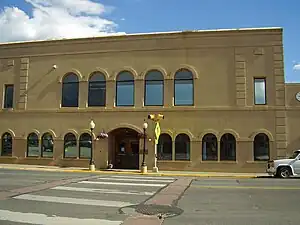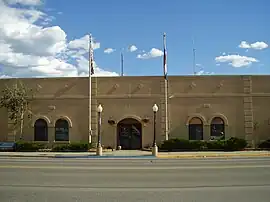Archuleta County | |
|---|---|
 Archuleta County Courthouse | |
 Location within the U.S. state of Colorado | |
 Colorado's location within the U.S. | |
| Coordinates: 37°11′N 107°03′W / 37.19°N 107.05°W | |
| Country | |
| State | |
| Founded | April 14, 1885 |
| Named for | Antonio D. Archuleta |
| Seat | Pagosa Springs |
| Largest town | Pagosa Springs |
| Area | |
| • Total | 1,356 sq mi (3,510 km2) |
| • Land | 1,350 sq mi (3,500 km2) |
| • Water | 5.3 sq mi (14 km2) 0.4% |
| Population (2020) | |
| • Total | 13,359 |
| • Density | 9.9/sq mi (3.8/km2) |
| Time zone | UTC−7 (Mountain) |
| • Summer (DST) | UTC−6 (MDT) |
| Congressional district | 3rd |
| Website | www |

Archuleta County is a county located in the U.S. state of Colorado. As of the 2020 census, the population was 13,359.[1] The county seat and the only incorporated municipality in the county is Pagosa Springs.[2]
History
Archuleta County was created by the Colorado legislature on April 14, 1885, out of western Conejos County. It was named for Jose Manuel Archuleta, "head of one of the old Spanish families of New Mexico",[3] and in honor of his son Antonio D. Archuleta, who was the Senator from Conejos County at the time.
Geography
According to the U.S. Census Bureau, the county has a total area of 1,356 square miles (3,510 km2), of which 1,350 square miles (3,500 km2) is land and 5.3 square miles (14 km2) (0.4%) is water.[4]
Adjacent counties
- Mineral County, Colorado - north
- Rio Grande County, Colorado - northeast
- Conejos County, Colorado - east
- Rio Arriba County, New Mexico - south
- San Juan County, New Mexico - southwest
- La Plata County, Colorado - west
- Hinsdale County, Colorado - northwest
Airport
Major highways
National protected areas
- Rio Grande National Forest
- San Juan National Forest
- Chimney Rock National Monument
- South San Juan Wilderness
| Census | Pop. | Note | %± |
|---|---|---|---|
| 1890 | 826 | — | |
| 1900 | 2,117 | 156.3% | |
| 1910 | 3,302 | 56.0% | |
| 1920 | 3,590 | 8.7% | |
| 1930 | 3,204 | −10.8% | |
| 1940 | 3,806 | 18.8% | |
| 1950 | 3,030 | −20.4% | |
| 1960 | 2,629 | −13.2% | |
| 1970 | 2,733 | 4.0% | |
| 1980 | 3,664 | 34.1% | |
| 1990 | 5,345 | 45.9% | |
| 2000 | 9,898 | 85.2% | |
| 2010 | 12,084 | 22.1% | |
| 2020 | 13,359 | 10.6% | |
| U.S. Decennial Census[5] 1790-1960[6] 1900-1990[7] 1990-2000[8] | |||
State protected area
Scenic and historic trails
Waterways
- Chamita River
- Dutton Creek
- Little Navajo River
- Martinez Creek
- McCabe Creek
- Mill Creek
- Piedra River
- Rio Blanco
- Rio Chama
- San Juan River
- Stollsteimer Creek [9][10]
- Williams Creek
Demographics
According to the 2020 census, there were 13,359 people, 5,736 households living in the county. The average household size was 2.34 persons. The population density was 9.9 people per square mile (3.8 people/km2). As of 2021, there were 9,693 housing units at an average density of 7.2 per square mile (2.8/km2). The racial makeup of the county was 90.9% White, 0.9% Black or African American, 3.8% Native American, 1.2% Asian, 0.2% Pacific Islander, and 3.1% from two or more races. 18.5% of the population were Hispanic or Latino of any race.[1]
The age distribution was 4.1% under 5 years, 17.5% under 18 years, 51.1% between 18 and 64 years, and 27.3% 65 years or older. 49.9% were female.[1]
The median household income (in 2020 dollars) was $55,658. The per capita income for the county was $32,995. About 9.40% of the population were at or below the poverty line.[1]
Politics
As of January 2022, Archuleta County had approximately 10,696 active registered voters. There were 40.6% unaffiliated with a party, 38.3% Republican, 19.6% Democrat, .8% Libertarian, .2% Green, and .5% various other parties.[11]
Voting in the county tends to favor conservative choices, especially at the state and national level, but winning elections for unaffiliated local candidates are not uncommon.[12]
| Republican | Democrat | Unaffiliated | |
| 2022, District 3 | 62.30% | 37.70% | |
| 2020, District 1 | 50.30% | 49.70% | |
| 2020, District 2 | 52.00% | 48.00% | |
| 2018, District 3 | 97.20% | 2.80% | |
| 2016, District 1 | 48.50% | 21.80% | 29.70% |
| 2016, District 2 | 56.40% | 20.70% | 22.90% |
| 2014, District 3 | 46.90% | 53.10% | |
| 2012, District 1 | 85.70% | 14.30% | |
| 2012, District 2 | 61.90% | 38.10% | |
| 2010, District 3 | 42.50% | 57.50% |
| Year | Republican | Democratic | Third party | |||
|---|---|---|---|---|---|---|
| No. | % | No. | % | No. | % | |
| 2020 | 5,189 | 56.75% | 3,738 | 40.88% | 217 | 2.37% |
| 2016 | 4,264 | 58.10% | 2,500 | 34.06% | 575 | 7.83% |
| 2012 | 3,872 | 57.50% | 2,679 | 39.78% | 183 | 2.72% |
| 2008 | 3,638 | 54.91% | 2,836 | 42.81% | 151 | 2.28% |
| 2004 | 3,601 | 61.67% | 2,141 | 36.67% | 97 | 1.66% |
| 2000 | 2,988 | 62.80% | 1,432 | 30.10% | 338 | 7.10% |
| 1996 | 1,963 | 57.11% | 997 | 29.01% | 477 | 13.88% |
| 1992 | 1,242 | 44.11% | 819 | 29.08% | 755 | 26.81% |
| 1988 | 1,440 | 63.66% | 795 | 35.15% | 27 | 1.19% |
| 1984 | 1,557 | 71.98% | 584 | 27.00% | 22 | 1.02% |
| 1980 | 1,252 | 65.89% | 532 | 28.00% | 116 | 6.11% |
| 1976 | 768 | 53.63% | 632 | 44.13% | 32 | 2.23% |
| 1972 | 606 | 64.47% | 300 | 31.91% | 34 | 3.62% |
| 1968 | 486 | 49.69% | 409 | 41.82% | 83 | 8.49% |
| 1964 | 370 | 36.71% | 632 | 62.70% | 6 | 0.60% |
| 1960 | 489 | 46.26% | 567 | 53.64% | 1 | 0.09% |
| 1956 | 635 | 59.91% | 423 | 39.91% | 2 | 0.19% |
| 1952 | 691 | 64.58% | 377 | 35.23% | 2 | 0.19% |
| 1948 | 597 | 55.07% | 479 | 44.19% | 8 | 0.74% |
| 1944 | 602 | 58.45% | 427 | 41.46% | 1 | 0.10% |
| 1940 | 869 | 53.71% | 744 | 45.98% | 5 | 0.31% |
| 1936 | 541 | 40.59% | 761 | 57.09% | 31 | 2.33% |
| 1932 | 462 | 32.77% | 928 | 65.82% | 20 | 1.42% |
| 1928 | 610 | 56.48% | 447 | 41.39% | 23 | 2.13% |
| 1924 | 451 | 43.12% | 269 | 25.72% | 326 | 31.17% |
| 1920 | 700 | 63.12% | 379 | 34.17% | 30 | 2.71% |
| 1916 | 473 | 35.70% | 830 | 62.64% | 22 | 1.66% |
| 1912 | 452 | 28.88% | 609 | 38.91% | 504 | 32.20% |
Communities
Town
Census-designated place
Other unincorporated places
Education
School districts include:[17]
- Archuleta County School District 50-JT
- Bayfield School District 10 JT-R
- Ignacio School District 11-JT
See also
References
- 1 2 3 4 "U.S. Census Bureau QuickFacts: Archuleta County, Colorado". www.census.gov. Retrieved July 18, 2022.
- ↑ "Find a County". National Association of Counties. Archived from the original on May 31, 2011. Retrieved June 7, 2011.
- ↑ Gannett, Henry (1905). The Origin of Certain Place Names in the United States. U.S. Government Printing Office. pp. 28.
- ↑ "US Gazetteer files: 2010, 2000, and 1990". United States Census Bureau. February 12, 2011. Retrieved April 23, 2011.
- ↑ "U.S. Decennial Census". United States Census Bureau. Retrieved June 7, 2014.
- ↑ "Historical Census Browser". University of Virginia Library. Retrieved June 7, 2014.
- ↑ "Population of Counties by Decennial Census: 1900 to 1990". United States Census Bureau. Retrieved June 7, 2014.
- ↑ "Census 2000 PHC-T-4. Ranking Tables for Counties: 1990 and 2000" (PDF). United States Census Bureau. Archived (PDF) from the original on March 27, 2010. Retrieved June 7, 2014.
- ↑ "STOLLSTEIMER CREEK AT STOLLSTEIMER SCHOOL". waterdata.usgs.gov. Retrieved November 17, 2022.
- ↑ Dicklyon (September 22, 2019), Picture: Stollsteimer Creek at Old Gallegos Road, Stollsteimer, Colorado, just before it joins the Piedra River, retrieved July 18, 2022
- ↑ "2022 Voter Registration Statistics". www.sos.state.co.us. Retrieved July 18, 2022.
- 1 2 "Election Results | Archuleta County, CO - Official Website". www.archuletacounty.org. Retrieved July 18, 2022.
- ↑ Error in Template:Align: the alignment setting "left cite web" is invalid.
- ↑ "Archuleta County Colorado History". genealogytrails.com. Retrieved November 17, 2022.
- ↑ "Mineral Resources Online Spatial Data; Dyke, CO". mrdata.usgs.gov. Retrieved November 17, 2022.
- ↑ "VFRMAP - Digital Aeronautical Charts; Dyke, CO". vfrmap.com. Retrieved November 17, 2022.
- ↑ "2020 CENSUS - SCHOOL DISTRICT REFERENCE MAP: Archuleta County, CO" (PDF). U.S. Census Bureau. Archived (PDF) from the original on July 13, 2022. Retrieved July 15, 2022. - Text list